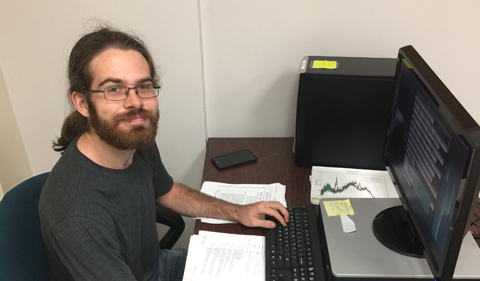Performing statistical nuclear reaction calculations can be difficult, since they require inputs at a level of expertise which non-specialists often lack. Ohio University nuclear astrophysicist, Dr. Zach Meisel, decided to enlist the help of a student computer programmer last summer to write code to simplify the process.
Meisel invited OHIO Russ College of Engineering and Technology undergraduate Matt Brooks (B.S. Electrical Engineering and Computer Science ’18) to come on board at the Edwards Accelerator Lab to develop a graphical interface to be used by Meisel and his research group, as well as other colleagues working at OHIO’s Institute of Nuclear and Particle Physics. Meisel is Assistant Professor of Physics & Astronomy.
The probability two nuclei will interact and make certain nuclear reaction products is described by a quantity known as the cross section, Meisel explained. For many nuclei, statistical estimates of the properties of nuclei involved in the reaction can be used to calculate the cross section using the so-called Hauser-Feshbach formalism.
To remedy this situation, Meisel asked Brooks to write a wrapper code they call Andiamo!, which assists users in performing Hauser-Feshbach calculations. The code will vastly simplify the process of identifying the relevant calculation inputs and selecting physical values for these inputs. The finished product will be a vital tool for Dr. Meisel’s research group and will likely become popular throughout the nuclear physics community.
Brooks worked diligently on the project throughout the summer well into the academic year. Andiamo! is slated to be available as open source at no cost to users in late Spring 2018.
“Dr. Steven Grimes named the project Andiamo! because it is Italian for “Let’s go!”, said Brooks. “Dr. Grimes travels a lot during his research, and being optimistic about the project, he thought an exciting foreign phrase would fit. At the start of the project, when it was still just a tiny thing, I gave it the pet name “Andy.” Developing Andiamo! was a learning process. At the beginning, I knew only the very basics of “how to draw a picture file to the window.” I have been learning the entire time.”
Brooks viewed his work with Meisel as an opportunity to master click detection, surface blitting, memory management, text entry, and how to use derivative classes.
“More than that, Andiamo! interested me,” Brooks says, “Because it was something that would make people’s jobs easier. A few highlights for me were all of the new things I was able to learn as I went, and the pleasant interactions with the staff at the Edwards Lab. I often would have questions for them about the Hauser-Feshbach code and they went to great lengths to help me understand how the code works, and how Andiamo! must interact with it.”
Meisel is more than satisfied with the results. “It has been extremely valuable to have an engineer working on this project, as the programming complexity is beyond what is typically required for physics research,” he said. “For Matt, I think he has enjoyed putting his programming skills to use for a real world project. He’s taken ownership of this project and has done a great job seeing it to completion.”




















Comments